Deformation and metamorphism
© All photographs on this webpage may be downloaded and used for teaching purposes only. The photographs may not be reproduced in any publications - commercial or scientific - without permission by Ralf Hetzel.
© All photographs on this webpage may be downloaded and used for teaching purposes only. The photographs may not be reproduced in any publications - commercial or scientific - without permission by Ralf Hetzel.
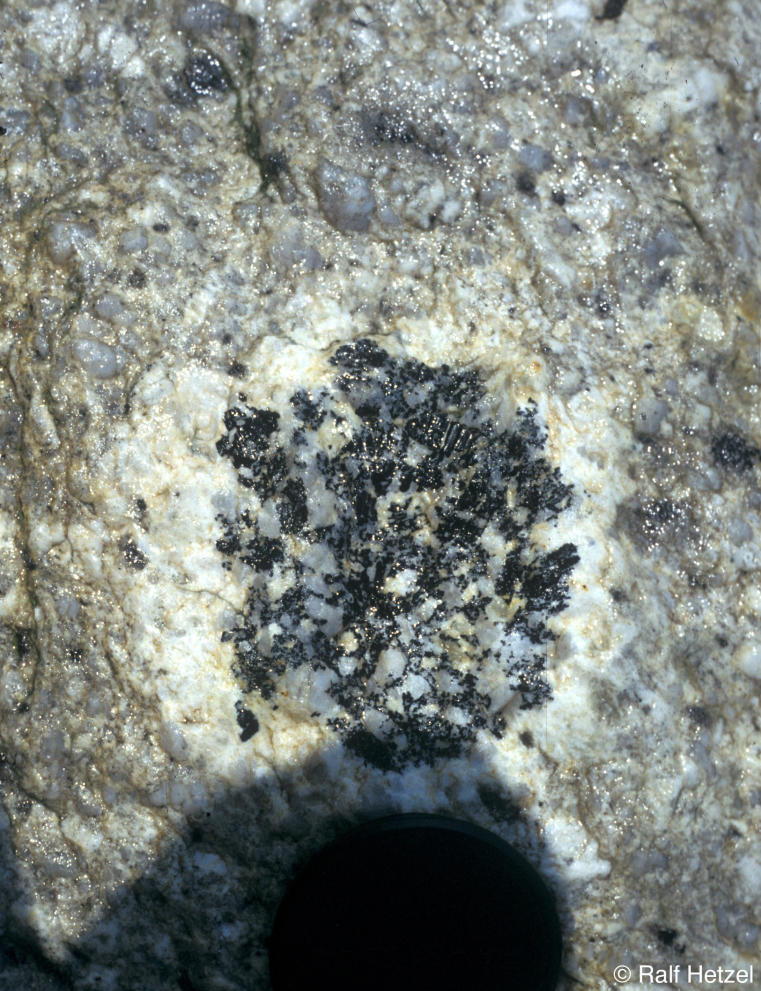
Download full size image (1,2 MB)
Undeformed spherical aggregate consisting of tourmaline, quartz, and feldspar in a 550-Ma-old granite (southern Menderes Massif, SW Turkey). Width of photograph is about 10cm.
Related Publications:
Hetzel R., Reischmann T. (1996). Intrusion age of Pan-African augen gneisses in the southern Menderes Massif and the age of cooling after Alpine ductile extensional deformation. Geological Magazine 133, 565-572.
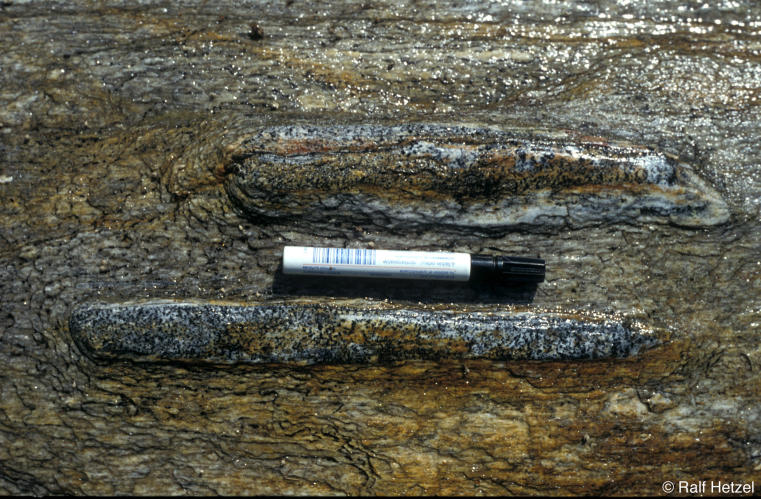
Download full size image (1,4 MB)
Deformed tourmaline-quartz-feldspar aggregate (X-Y section) in a ductile shear zone (southern Menderes Massif, SW Turkey). For an undeformed aggregate see Picture 1a. Length of pencil is 13 cm.
Related Publications:
Hetzel R., Reischmann T. (1996). Intrusion age of Pan-African augen gneisses in the southern Menderes Massif and the age of cooling after Alpine ductile extensional deformation. Geological Magazine 133, 565-572.
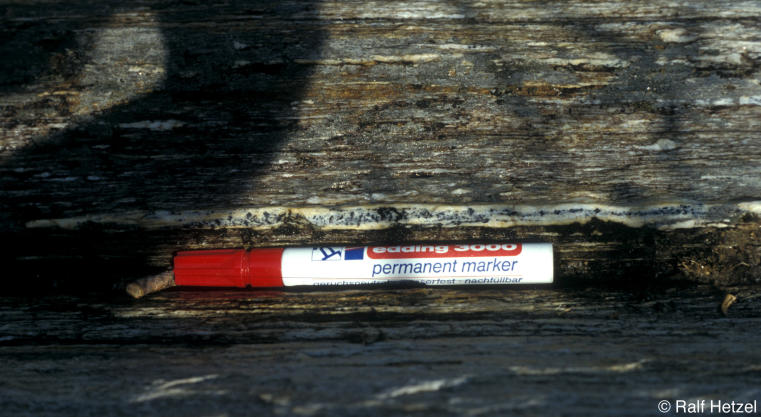
Download full size image (1,2 MB)
Deformed tourmaline-quartz-feldspar aggregate (X-Z section) in a ductile shear zone (southern Menderes Massif, SW Turkey). For an undeformed aggregate see Picture 1a. Length of pencil is 13 cm.
Related Publications:
Hetzel R., Reischmann T. (1996). Intrusion age of Pan-African augen gneisses in the southern Menderes Massif and the age of cooling after Alpine ductile extensional deformation. Geological Magazine 133, 565-572.
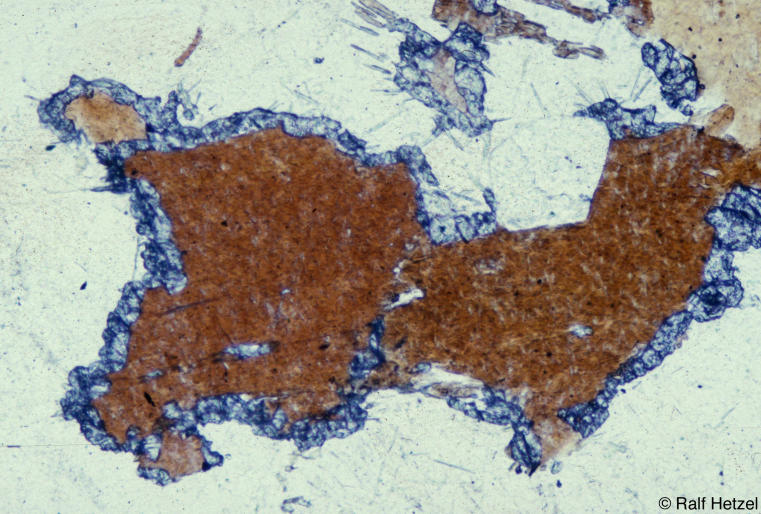
Download full size image (1,5 MB)
Thin section photograph (plane-polarized light) of a metamorphosed granite. During prograde metamorphism magmatic biotite (brown) has been transformed to garnet (grey minerals with high "relief") along the rim. Width of photograph is about 1.5 mm.
Related Publications:
Hetzel R., Romer R.L., Candan O., Passchier C.W. (1998). Geology of the Bozdag area, central Menderes Massif, SW Turkey: Pan-African basement and Alpine deformation. Geologische Rundschau 87, 394-406.
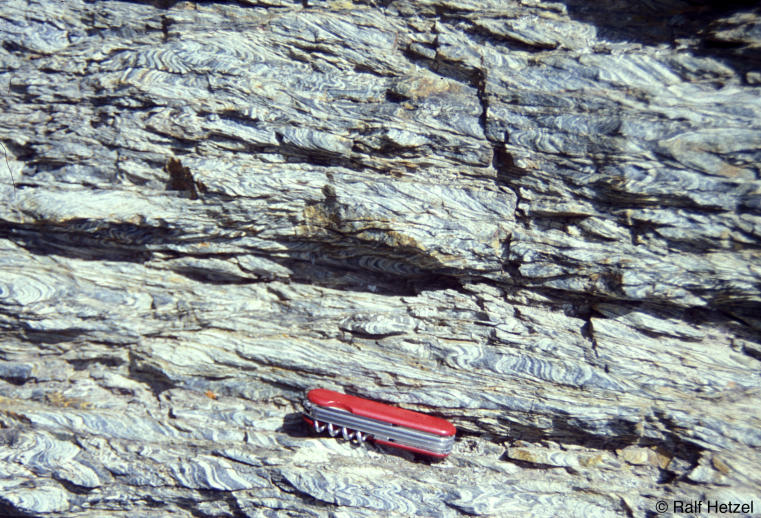
Download full size image (1,4 MB)
Crenulation cleavage in lower greenschist facies metasediments. The long axis of the Swiss knife is parallel to the crenulation cleavage.
Related Publications:
Echtler H.P., Hetzel R. (1997). Main Uralian Thrust and Main Uralian Normal Fault: non-extensional Paleozoic high-P rock exhumation, oblique collision, and normal faulting in the Southern Urals. Terra Nova 9, 158-162.
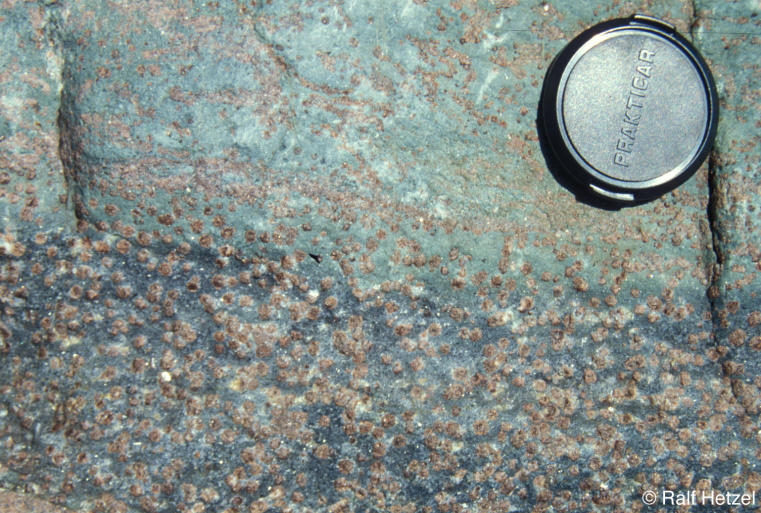
Download full size image (1,9 MB)
Transition between eclogite consisting of red garnet and green omphacite (upper part of picture) and blueschist (lower part) in the Maksyutov Complex, Southern Urals. The blueschist is made up of blue amphibole, red garnet, and minor amounts of phengite and epidote. Both eclogite and blueschist formed during a single high-P/low-T metamorphic event. The contemporaneous formation of the two rock types during one metamorphic event is readily explained by their different bulk composition. Object for scale is 6 cm in diameter.
Related Publications:
Hetzel R., Echtler H.P., Seifert W., Schulte A.B., Ivanov K.S. (1998). Subduction- and exhumation-related fabrics in the Paleozoic high-P/low-T Maksyutov Complex, Antingan area, Southern Urals, Russia. Geological Society of America Bulletin 110, 916-930.

Download full size image (1,8 MB)
Blueschist made up of blue amphibole, red garnet, and minor amounts of green omphacite and white mica (phengite) (Maksyutov Complex, Southern Urals).
Related Publications:
Hetzel R., Echtler H.P., Seifert W., Schulte A.B., Ivanov K.S. (1998). Subduction- and exhumation-related fabrics in the Paleozoic high-P/low-T Maksyutov Complex, Antingan area, Southern Urals, Russia. Geological Society of America Bulletin 110, 916-930.
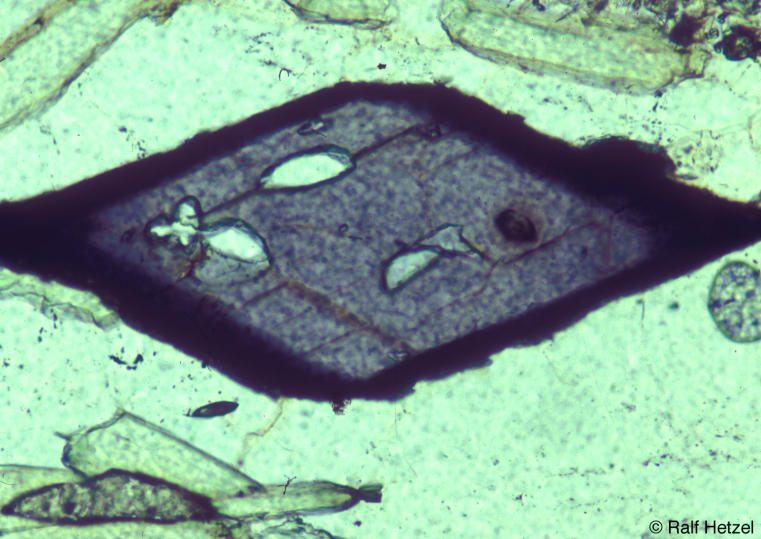
Download full size image (1,7 MB)
Thin section of zoned alkali amphibole in a metapelite. The mineral zonation of the amphibole reflects the retrograde metamorphic evolution in the high-pressure Maksyutov Complex, Southern Urals. The light-blue core of the amphibole consists of glaucophane, the dark blue rim is composed of crossite.
Related Publications:
Hetzel R., Echtler H.P., Seifert W., Schulte A.B., Ivanov K.S. (1998). Subduction- and exhumation-related fabrics in the Paleozoic high-P/low-T Maksyutov Complex, Antingan area, Southern Urals, Russia. Geological Society of America Bulletin 110: 916-930.
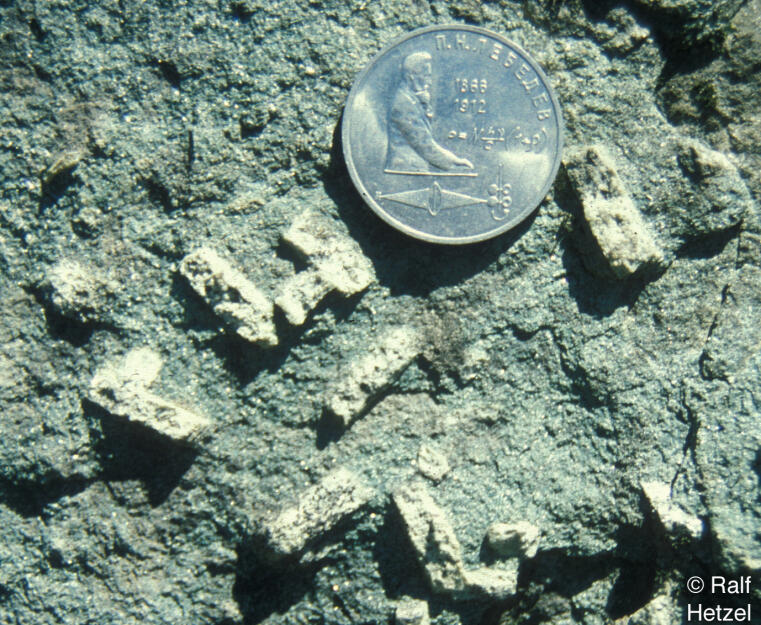
Download full size image (1,1 MB)
Lawsonite pseudomorphs (white) in a meta-rodingite indicate a blueschist-facies metamorphic event (Maksyutov Complex, Southern Urals). During retrogression and fluid infiltration at greenschist facies conditions the lawsonite porphyroblasts were completely replaced by clinozoisite and muscovite.
Related Publications:
Hetzel R. (1999). Geology and geodynamic evolution of the high-P/low-T Maksyutov Complex, Southern Urals, Russia. Geologische Rundschau 87, 577-588.
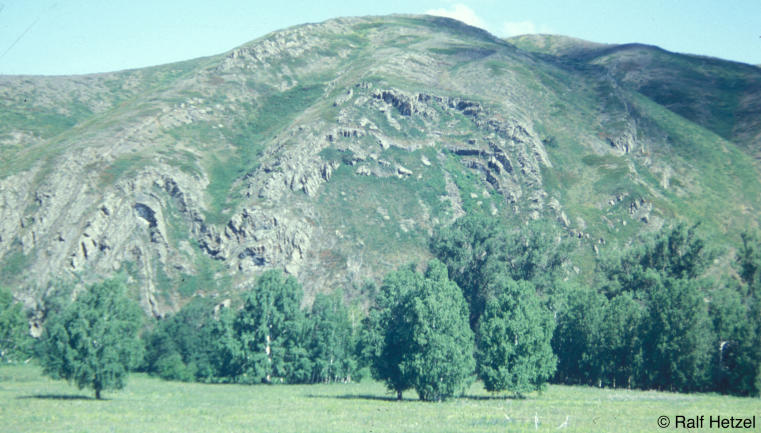
Download full size image (1,9 MB)
Large-scale symmetric folds in the Zilair flysch, Southern Urals.
Related Publications:
D. Brown, P. Spadea, V. Puchkov, J. Alvarez-Marron, R. Herrington, A. Willner, R. Hetzel, Y. Gorozhanina (in press). Arc-continent collision in the Southern Urals. Earth Science Reviews.
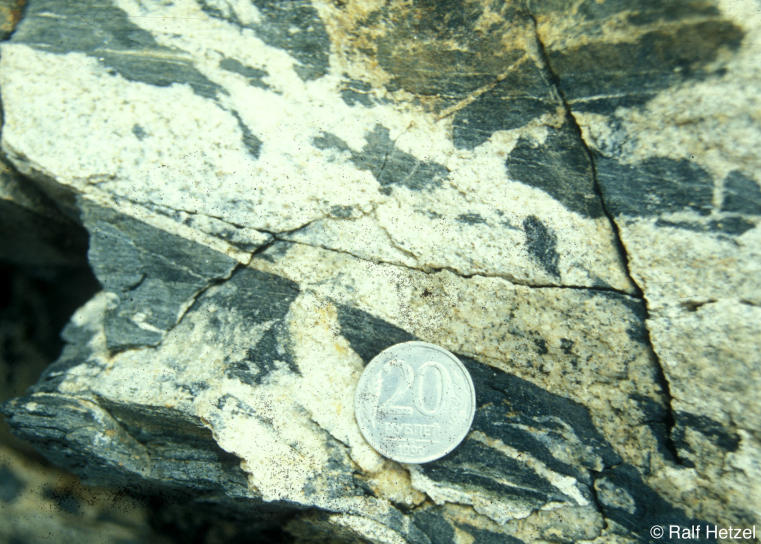
Download full size image (1,0 MB)
Post-tectonic granitoid cross-cutting the tectonic foliation of an intensely deformed amphibolite in the Middle Urals. Coin is 3 cm in diameter.
Related Publications:
Hetzel R., Romer R.L. (1999). U-Pb dating of the Verkniy Ufaley intrusion, Middle Urals, Russia: A minimum age for subduction and amphibolite facies overprint of the East European continental margin. Geological Magazine 136, 593-597.
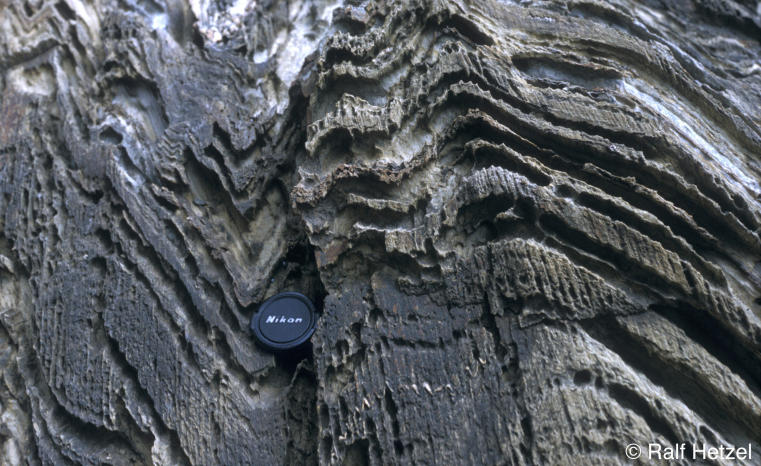
Download full size image (1,1 MB)
Axial planar cleavage in folded metasediments. The folded sedimentary layering (S0) is recognized owing to the differential weathering of the individual layers. The planar cleavage (S1) is oriented subvertical. Object for scale is 6 cm in diameter.
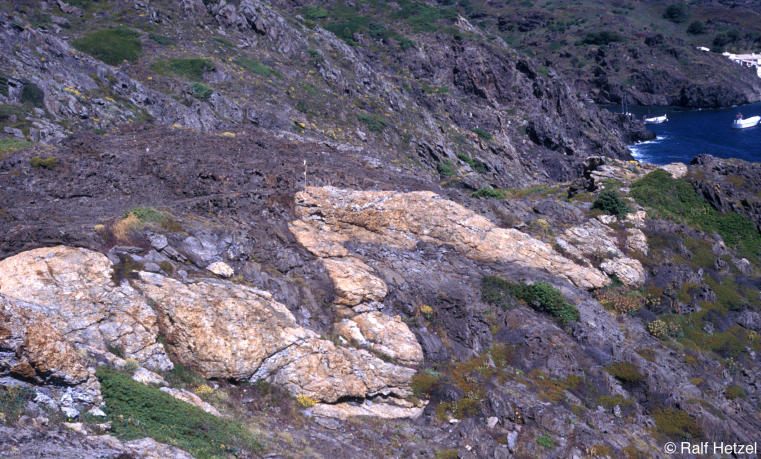
Download full size image (1,6 MB)
Folded pegmatite dyke in dark metasediments.
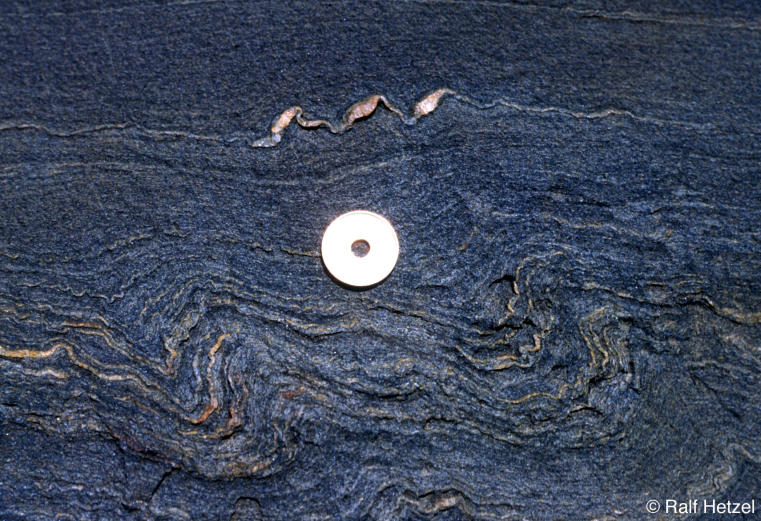
Download full size image (979 KB)
Three folded quartz boudins (upper part of image) indicate two phases of deformation. A first phase has led to the boudinage of the quartz veins. During a subsequent deformation phase the boudins have been folded. Coin is 2.5 cm in diameter.
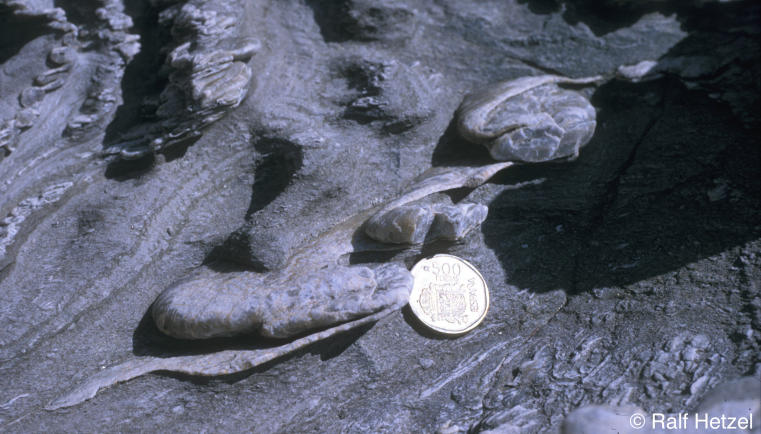
Download full size image (1,1 MB)
Small-scale sheath folds developed in quartz veins. Coin is 3 cm in diameter.
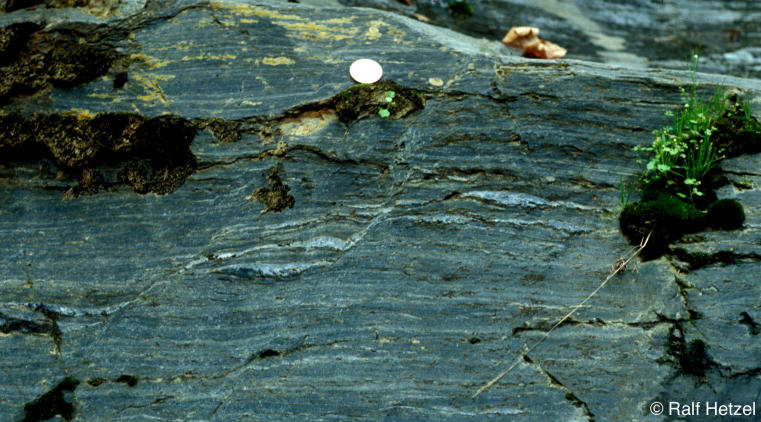
Download full size image (1,1 MB)
Two quartz veins, which are parallel to the horizontal foliation in a dark grey cataclasite, are offset by two normal faults (dipping to the left). Coin in central upper part of image is 2.5 cm in diameter.
Related Publications:
Hetzel R., Ring U., Akal C., Troesch M. (1995). Miocene NNE-directed extensional unroofing in the Menderes Massif, SW Turkey. Journal of the Geological Society of London 152, 639-654.